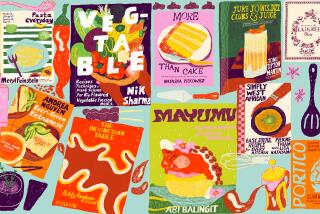The Case of the Foaming Root
- Share via
There was no warning, none at all.
The afternoon sun shone mildly through the windows of the secluded Chelsea apartment where I was working in the 19th year of my 20-year assignment to write “The Oxford Companion to Food.” Then my collaborator, Helen J. Saberi, casually asked the fateful question: “Do you know what bois de Panama is?”
There was nothing to suggest that she was opening a door through which both of us would be propelled into a nightmare world of stark white foams, rising out of bowl after bowl of macerated bark or root to enrobe an infinity of Lebanese and Egyptian sweetmeats; a scene which, for suave horror, outdoes any Breughelesque vision of Hell. There was no hint that I would become librarian of a newly formed international organization called INTERSPI (or International Spice Investigations, if you prefer), dedicated to hunting down those few rogue flavorings that eluded the attention of Vasco da Gama, Magellan and all the other spice-mad explorers of yesteryear.
In helping her friend Anissa Helou test recipes for a cookbook (“Lebanese Cuisine” Grub Street: London; 1994), Saberi had innocently become curious about the Middle Eastern habit of combining pastries with a non-dairy “cream” called natif (others have spelled it natife and naatiffe ), which calls for bois de Panama. Claudia Roden, in “A New Book of Middle Eastern Food” (Viking: 1985), described bois de Panama as “a pale, dry wood” that could be made to produce the foaming white sauce she knew as a child in Egypt. Helou had a stock of two sorts of bois de Panama her mother had bought in Lebanon--one a root, the other a bark--and though she could not give its botanical identity, she said she could make us natif from each kind.
*
Thus the nightmare began. Every five minutes, it seemed, Helou would bring yet another collection of aluminum trays full of foam, some made by herself and some by Lebanese confectioners in London. Foam enveloped us; not a light, frothy foam you could blow off your hands, but a thick, shiny, unctuous, marshmallow-like foam of an eerie whiteness that had nothing cream-like about it.
As the containers piled up in our previously tranquil workroom, I searched through the 99 books in our library that have titles like “The Definitive, Comprehensive, Seek-No-Further, This-Time-We’re-Not-Kidding, Really All-Inclusive Book on the World’s Spices” and finding nothing on bois de Panama apart from a mention in an 1898 French book, Albert Seigneurie’s “Dictionnaire Encyclopedique de l’Epicerie.” Seigneurie wrote that b. de P. (as we now called it) was the bark of the Central American soap bark tree, Quillaja saponaria , which would foam when pulverized and mixed with water. It was sold as a sort of soap; no mention of any food use.
That was when INTERSPI was established. A trail that had gone cold in 1898 called for more than uncoordinated amateur investigation. Saberi (now Detective Superintendent Saberi) assigned me, as librarian, to continue hunting through books (I am a bookish person) and tasting samples (I like Lebanese pastries) indefinitely, while she faxed queries around the world to chemists, botanists, linguists, food historians and pastry cooks.
*
A Colombian chemist working in Switzerland came up with the information that the majestic “Fenarolo’s Handbook of Flavor Ingredients” (Cleveland: 1971) positively identified b. de P. as Quillaja saponaria and said reassuringly that the saponins that give it its foaming quality have “only low long-term toxicity.” Saberi worried that certain investigators might be researching it in dangerous quantities. Happily, all but one have continued reporting back to HQ, the exception being Palo Alto food-science writer Harold McGee, who has not been heard from for weeks. (Henceforth we will include health warnings with all samples.)
We now believe there are not one or two but at least three plant substances that produce the b. de P. effect: 1) the Central American tree (now also being grown in North Africa, according to one U.S. source), though how it should have become a traditional ingredient in the Near East remains mysterious; 2) Saponaria officinalis , or common soapwort, a shrubby plant found in Europe, the Near East and elsewhere, the sap of which has been used as soap, and 3) Gypsophila paniculata , sometimes called soapwort root, which turns out to be an old friend--it’s one of the two plants florists call baby’s breath. Two types of b. de P.-type plants are now undergoing long-term investigation by the Royal Botanic Garden at Kew, which has so far told us only that, whatever it is, b. de P. is one of the very few spices commonly used in fire extinguishers.
What will be the result of our quest for the true, authentic b. de P.? Inevitably, further growth in the size of INTERSPI. We have already had applications for admission from the likes of Prof. Arthur Tucker of Delaware State University and have committed ourselves to an annual dinner, a major international event at which Lebanese pastries will surely be on the menu.
*
But INTERSPI is not growing just because of the laws that cause the exponential growth of all new international organizations; it is growing because its subject matter, like a huge subterranean tide of white suds, has been soundlessly welling up and spreading. We have uneasy memories of the Stay-Puft Marshmallow Man in “Ghostbusters.”
*
Those who have puzzled over the recipe for “naatiffe cream” in Claudia Roden’s “A New Book of Middle Eastern Food” may feel like essaying a batch of natif, which has a texture a bit like seven-minute frosting and a curious, bittersweet flavor more like a tea than a spice. Of course, it requires finding soap bark, wort or root; your best bet is an herbalist or Latino botanica. We bought soap bark at Herbs of Mexico (3903 Whittier Blvd., East Los Angeles; (213) 261-2521), which sells it already quite thoroughly chopped up.
We have found the recipe in Anissa Helou’s book easier than Roden’s, which calls for an unrealistically small amount of water. Unlike Roden’s recipe, Helou’s does not contain beaten egg white. It can be used as a sauce for the Arab molded butter cookies called maamoul. In Central Asian countries such as Uzbekistan, where natif (always including beaten egg white) is known as nishalla, it is eaten by itself as a sort of pudding.
BOIS DE PANAMA SAUCE (Natif)
2 ounces bois de Panama (soap bark), soap wort or soap wort root
2 1/2 cups water
Citrus Syrup
Chop bois de Panama small or pulverize. Rinse to remove any grit. Place in large saucepan, add water and boil until thickened and reduced to about 1/4 of original volume, about 10 minutes. Watch carefully. Mixture will foam and rise considerably.
Strain through cheesecloth into large mixing bowl. Beat at medium speed until mixture becomes very foamy, brilliant white and somewhat shiny, about 10 to 15 minutes. Gradually add warm Citrus Syrup and fold in well to make elastic mousse. Leave to cool before refrigerating. Serve as dip with butter cookies. Makes about 10 cups, enough for 40-50 cookies.
Citrus Syrup
1 1/4 cups sugar
1/2 cup water
1 tablespoon lemon juice
1 tablespoon rose or orange blossom water
Add sugar to water and cook over medium heat until dissolved. Then boil over high heat until temperature reaches 250 degrees, about 3 minutes. Stir in lemon juice and orange blossom water. Keep warm until use.
* Davidson is the editor of the forthcoming “Oxford Companion to Food” and the publisher of a thrice-yearly magazine of unusual food scholarship, Petits Propos Culinaires (for subscription, send check for $23.50, payable to Prospect Books Ltd., to 45 Lamont Road, London SW10 OHU).
More to Read
Eat your way across L.A.
Get our weekly Tasting Notes newsletter for reviews, news and more.
You may occasionally receive promotional content from the Los Angeles Times.










